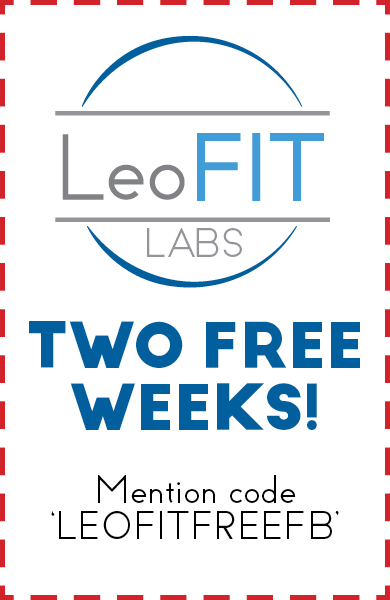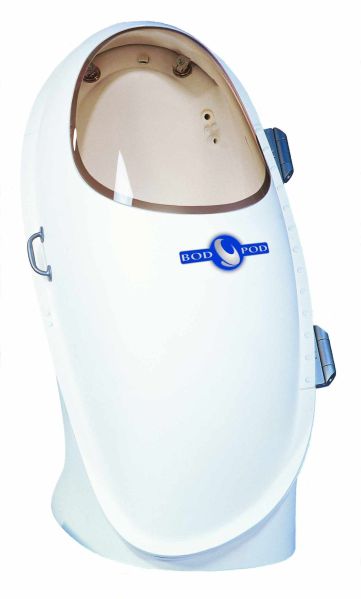Claim Your Two Weeks Free
The LEAST expensive and MOST effective Personal Training in San Diego at only $35 per session! We use intensity and not duration to bring about the scientifically proven fastest results.1

Present this coupon or mention offer code LEOFITFREEFB to redeem your first two weeks for free!
- Most people exercise because we want our bodies to change in some way.
- The primary change we are looking for is usually heath related such as to lose weight, get stronger, build muscle, or get more aerobically fit.
- The latest science has shown that traditional weight resistance training is extremely inefficient and that traditional aerobic activities take a lot of time, are very hard on your joints, and often cause the loss of lean muscle mass.
- Lean muscle gives the body its shape, and it burns three to five times more calories a day per pound than fat does. We also lose between 3-5% of our muscle every 10 years once past 30.2
- Science has proven that the absolute fastest way to build more muscle is to exercise a muscle to the point where you cannot lift the weight again.3 This is called muscle failure.
- Muscles work in two directions, positive and negative. Positive is pushing the weight, as in doing a chest press. Negative is returning to the starting position. When doing resistance training, muscles do not reach full failure because they only require pushing in the positive direction. Gravity takes over in the negative direction, and the muscle is basically resting. So the muscle will go to failure in the positive direction only, but not in the negative direction.
- Our technology brings the muscle to failure in both the positive and negative directions, giving you the maximum muscle-building benefits in as little as 20 minutes just once a week.4 It isn’t necessary or desirable to exercise more often because a fully failed muscle needs 7 days to recover.4

- The large video display on the computer tracks your increase in strength each week. 95% of our clients get stronger each week for months and even years. It displays this week’s graph (in black and red) versus last weeks (light gray). You also have a personal trainer to guide and encourage you.

- The computer will never push harder than you can safely resist. If you stop pushing, the machine stops instantly, making it safe for anyone from age 10 to 100.
- This short intense workout will also provide more aerobic benefits than several hours of normal aerobic training.5
- We offer a second technology that uses High Intensity Interval Training (HIIT).6 Its unique cooling technology and compression therapy give you more benefit in a single 20 minute session than several hours of traditional aerobic training.7

- Our third technology is a medical-grade body composition instrument that will precisely calculate your current percentage of muscle versus body fat. On a traditional diet, with or without exercise, most people lose a significant amount of lean muscle as well as some fat. This technology identifies increases in lean muscle, minimizes loss of lean muscle when dieting, and tracks fat loss.

The scientifically proven benefits of our methods in as little as one session a week:
- Reduced body fat levels8
- Increased strength5
- Enhanced cardiovascular efficiency9
- Lower cholesterol levels10
- Reduced chance of injury11
- Stronger immune system12
- Complete metabolic health13
- Increased bone density14
- Reduced risk of Type II diabetes15
- Reduced blood pressure16
You will NOT believe the effectiveness and time savings of this training until you try it! Once you experience it, you will completely UNDERSTAND why all the above benefits are possible in such a short amount of time.
CALL TO SCHEDULE YOUR FREE INTRODUCTORY WORKOUT TODAY!
CALL NOW: 619-299-1694
E-mail: [email protected]
1851 San Diego Avenue Suite 100A
San Diego, CA 92110
- Willardson JM. The application of training to failure in periodized multiple set resistance exercise programs. J Strength Cond Res 2007; 21: 628-31. See also Rodney KJ, Herbert RD, Balnave RJ. Fatigue contributes to the strength training stimulus. Med Sci Sports Exerc 1994; 26: 1160-4.
- https://www.webmd.com/healthy-aging/guide/sarcopenia-with-aging#1
- Physiologists Carpinelli and Otto reviewed all of the known studies on the optimal number of sets performed for the purpose of increasing size and strength, and found that single sets produced optimal results in 33 studies out of the 35 they reviewed: Carpinelli RN, Otto RM. Strength training: single versus multiple sets. Sports Med 1998; 26: 73-84.
- Carpinelli R, Otto RM, Winett RA. A critical analysis of the ACSM position stand on resistance training: insufficient evidence to support recommended training protocols. J Exerc Physiol 2004; 7: 1-60.; See also Smith D, Bruce-Low S. Strength training and the work of Arthur Jones. J Exerc Physiol 2004; 7: 52-68, and Newham, D. J., Jones, D. A., and Clarkson, P. M. Repeated high-force eccentric exercise: effects on muscle pain and damage. Journal of Applied Physiology 1987; 63(4): 1381-1386
- Messier, S.P., Dill, M.E., “Alterations in strength and maximum oxy- gen consumption consequent to nautilus circuit weight training.” Res Q Exerc Sport 56 (1985) 345–
- A. Burgomaster, S. C. Hughes, G. J. F. Heigenhauser, S. N. Bradwell, and M. J. Gibala, “Six Sessions of Sprint Interval Training Increases Muscle Oxidative Potential and Cycle Endurance Capacity in Humans,” Journal of Applied Physiology 98, no. 6 (June 1, 2005): 1985-90.
- F. Coyle, “Very Intense Exercise-Training Is Extremely Potent and Time Efficient: A Reminder,” ibid., 1983-84.
- Hurley BF, Roth SM. Strength training in the elderly: effects on risk factors for age-related diseases. Sports Med. 2000 Oct;30(4):249-68. Review. PubMed PMID: 11048773. See also Devries, M. C., Breen, L., Von Allmen, M., MacDonald, M. J., Moore, D. R., Offord, E. A., … Phillips, S. M. (2015). Low-load resistance training during step-reduction attenuates declines in muscle mass and strength and enhances anabolic sensitivity in older men. Physiological Reports, 3(8), e12493.
- Burt J, Wilson R, Willardson JM. A comparison of once versus twice per week training on leg press strength in women.J Sports Med Phys Fitness. 2007 Mar;47(1)
- https://www.ncbi.nlm.nih.gov/pubmed/3824017
- https://www.ncbi.nlm.nih.gov/pubmed/3633121
- https://www.couriermail.com.au/news/queensland/queensland-study-shows-resistance-exercises-can-boost-immunity/news-story/59db6b746b3ac0a6dd90fdb0a7d52bbc
- Campbell, W., Crim, M., Young, C., et al. “Increased energy require- ments and changes in body composition with resistance training in older adults.” Am J Clin Nutr 60 (1994)167–75. See also Hurley, B., “Does strength training improve health status?” Strength Cond J 16 (1994) 7–13. See also Stone, M., Blessing, D., Byrd, R., et al. “Physiological effects of a short term resistive training program on middle-aged untrained men.” Nat Strength Cond Assoc J 4 (1982) 16–20 and Hurley, B., Hagberg, J., Goldberg A., et al. “Resistance training can reduce coronary risk factors without altering VO2 max or percent body fat.” Med Sci Sports Exerc 20 (1988) 150–4
- Menkes A., Mazel S., Redmond A., et al., “Strength training increases regional bone mineral density and bone remodelling in middle-aged and older men.” J Appl Physiol 74 (1993) 2478–84.
- Baldi JC, Snowling N: Resistance training improves glycaemic control in obese type 2 diabetic men. Int J Sports Med24:419–423, 2003
- Colliander E.B. Tesch, P.A., “Blood pressure in resistance trained ath- letes.” Can J Appl Sport Sci 13 (1988) 31–4


